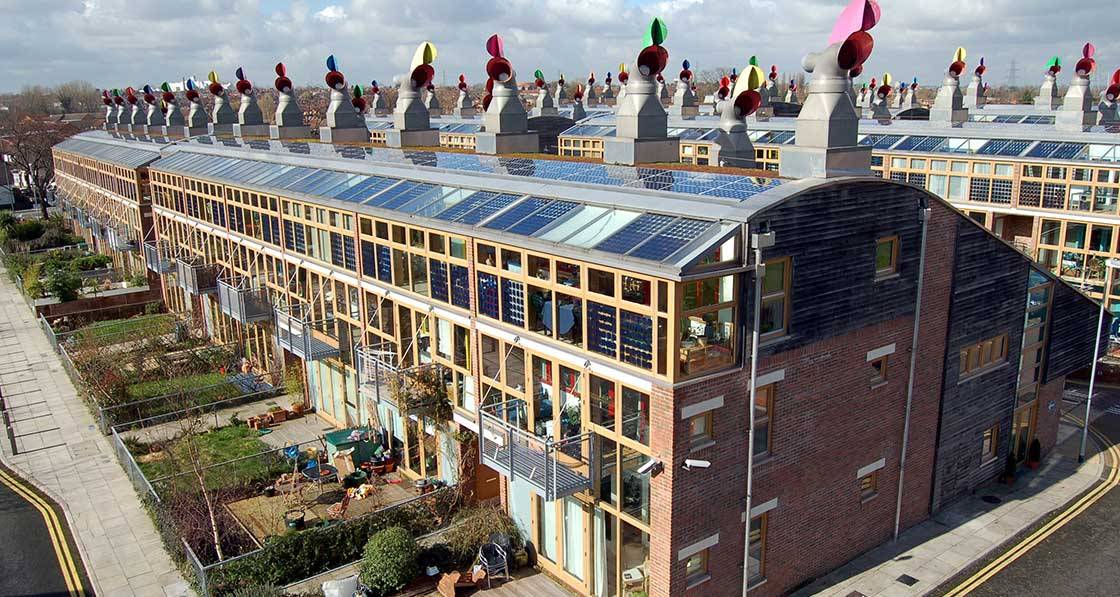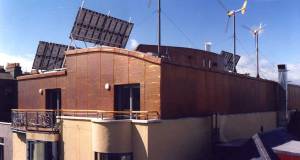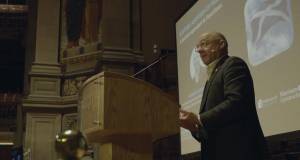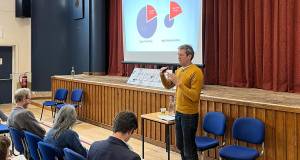
- Blogs
- Posted
Bedding sustainability into British buildings: Bioregional’s BedZed
This article was originally published in issue 46 of Passive House Plus magazine. Want immediate access to all back issues and exclusive extra content? Click here to subscribe for as little as €15, or click here to receive the next issue free of charge
In 2002, as governments across Europe started to integrate Kyoto protocol targets into building regulations, a medium sized mixed-use development outside London aspired to become a seminal low carbon super sustainable community.
BedZed tested a lot of sustainable concepts in a real world setting together with human behavioural change as a central focus. Some strategies worked better than others, but the scheme signposted the direction the rest of us had to take over the following 20 years.
The Beddington zero energy development was based in the London borough of Sutton, located close to a train line, including 100 homes, offices, a community centre, playing field, gardens and allotments. BedZed featured optimal southerly orientation for winter solar heat gain, a passive ventilation strategy, an aspect of heat exchange, double and triple glazed windows, southerly conservatories, super insulation, good airtightness, stack ventilation, plug load monitoring, photovoltaic panels and initially a combined heat and power-based district heating system. Many of the materials used in the construction of the buildings were reclaimed or sourced locally, thus reducing the embodied carbon by 20 per cent to 30 per cent.
The overall design resulted in a reported 90 per cent reduction in fixed loads, and a 56 per cent overall carbon reduction when compared to an average UK home, with all renewable energy accounting for 20 per cent of all site electrical demand. Note that at this time CHP was considered renewable, as the development intended to use reclaimed timber – which led to impurities impacting the performance of the CHP.
The profile of the building is designed to minimise overshadowing to the southerly face of the block to its rear. Passive ventilation combined with thermally massive materials help to offset heating needs. Conservatory doors are intended to be opened during the summer to allow for trapped heat to dissipate out, and prevent overheating, and in the winter internal doors with stack ventilation are intended to draw solar heat gain from the conservatory through the building. The CHP plant was less successful due to maintenance issues and as a result the company ceasing trading. The 2007 building occupancy survey showed that 56 per cent of occupants surveyed complained about overheating during the summer period. Research indicated that poor user education on the design principles of the houses and user behaviour mitigated against passive solar heat in winter and aggravated heat demand in the heating season. Looking forward 20 years from 2002, some of the learning outcomes might include the use of a mechanical ventilation heat recovery system combined with an air source heat pump as less complicated solutions to District CHP and natural ventilation, especially where we have better airtightness and control.
Other aspects of the sustainable design strategy included one car parking place per home, car sharing, free electric car charging with good links to public transport, and bicycle storage on site. This resulted in an average resident’s mileage of 3,138 per person, which would be 64 per cent lower than the average local area resident. While this is good, BedZed residents were three times more likely to fly abroad than local residents, mitigating against carbon offsetting targets.
The development also used a sustainable urban drainage system (SuDS), with permeable paving, green roofs, and a soak away ditch. Wastewater was treated with a mixture of biologically active sludge and reedbeds, an expensive system to run from an electrical standpoint. Rainfall collection is mixed with water to flush WCs, resulting in a 50 per cent lower use of water when compared to UK average.
Remotely located shared recycle bins are less successful because of distance and human behavioural issues. However, community composting, helped very much by peer education and chats with the neighbours, has been much more successful in local food gardens and allotments. Food is grown on site and accounts for an 8 per cent reduction in the total CO2 footprint. The local organic vegetables are sold on Sunday and Monday markets helping to build an inter-reliant community. Interestingly, BedZed residents know 20 people in the development by name, which is double the strong community benchmark of 10, with one person being able to name 150 neighbours. This is a testament to the design of the project by Bio-Regional and ZED Factory with Tom Chance.
BedZed was indeed a ground-breaking project which field-tested a combination of design and sustainability strategies, sometimes illustrating limitations, but becoming very successful in reducing the carbon footprint of its residents. It faced problems such as overheating and having to switch from CHP to gas which undermined its sustainability targets. That said the rest of us learnt that we need to depend on more reliable renewable energy solutions that are less prone to variable behavioural conditions. Natural ventilation is more problematic in urban contexts where privacy and security are an issue, leading to windows being closed and curtains been placed over windows. Even 20 years on we have a lot to learn from BedZed, in designing for better communities and delivering real CO2 reductions in terms of build, operation and lifestyle.
Much of this article is drawn from data published in a paper written by Tom Chance in 2009, the BedZed monitoring report by Jessica Hodge and Julia Haltrecht for BioRegional in 2007, and the findings of a PhD thesis by Janet Young in 2015.
Related items
-
 An early green building in a changing Ireland
An early green building in a changing Ireland -
Is shared equity a bridge too far?
-
 Scotland committed to continuing passive house journey
Scotland committed to continuing passive house journey -
ASBP Awards shortlist announced
-
 AECB conference 2023: from edible landscaping to whole life carbon
AECB conference 2023: from edible landscaping to whole life carbon -
 Free programme to bring passive house to UK architecture students
Free programme to bring passive house to UK architecture students





